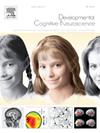皮层区域的一个子集在儿童早期表现出成人样的功能网络模式。
IF 4.9
2区 医学
Q1 NEUROSCIENCES
引用次数: 0
摘要
人类大脑皮层包含支持感觉、运动、认知和情感功能的区域群,通常被归类为功能网络。这些网络表现出较强的内部功能连通性和较弱的外部功能连通性(FC),并且在同一网络中FC特征更加相似。先前的研究表明,这些网络从出生前的新生形态发展到童年时期成熟的成人结构。然而,这些分析往往依赖于成人功能网络的定义。本研究评估了使用成人模型时对婴儿功能网络的潜在错误识别,并探讨了该问题的后果和可能的解决方案。我们的研究结果表明,尽管成人网络对婴儿FC组织的描述比偶然更好,但错误识别主要是由特定区域驱动的。将功能网络限制在具有成人样网络集群的区域,揭示了在扫描和整个发育过程中网络内FC的一致性。这些区域也靠近网络身份可变性低的位置。我们的研究结果强调了使用成人网络对婴儿的影响,并根据研究问题和场景为选择和利用功能网络模型提供了指导。本文章由计算机程序翻译,如有差异,请以英文原文为准。
A subset of cortical areas exhibit adult-like functional network patterns in early childhood
The human cerebral cortex contains groups of areas that support sensory, motor, cognitive, and affective functions, often categorized into functional networks. These networks show stronger internal and weaker external functional connectivity (FC), with FC profiles more similar within the same network. Previous studies have shown these networks develop from nascent forms before birth to their mature, adult-like structures in childhood. However, these analyses often rely on adult functional network definitions. This study assesses the potential misidentification of infant functional networks when using adult models and explores the consequences and possible solutions to this problem. Our findings suggest that although adult networks only marginally describe infant FC organization better than chance, misidentification is primarily driven by specific areas. Restricting functional networks to areas with adult-like network clustering revealed consistent within-network FC across scans and throughout development. These areas are also near locations with low network identity variability. Our results highlight the implications of using adult networks for infants and offer guidance for selecting and utilizing functional network models based on research questions and scenarios.
求助全文
通过发布文献求助,成功后即可免费获取论文全文。
去求助
来源期刊

Developmental Cognitive Neuroscience
NEUROSCIENCES-
CiteScore
7.60
自引率
10.60%
发文量
124
审稿时长
6-12 weeks
期刊介绍:
The journal publishes theoretical and research papers on cognitive brain development, from infancy through childhood and adolescence and into adulthood. It covers neurocognitive development and neurocognitive processing in both typical and atypical development, including social and affective aspects. Appropriate methodologies for the journal include, but are not limited to, functional neuroimaging (fMRI and MEG), electrophysiology (EEG and ERP), NIRS and transcranial magnetic stimulation, as well as other basic neuroscience approaches using cellular and animal models that directly address cognitive brain development, patient studies, case studies, post-mortem studies and pharmacological studies.
 求助内容:
求助内容: 应助结果提醒方式:
应助结果提醒方式:


